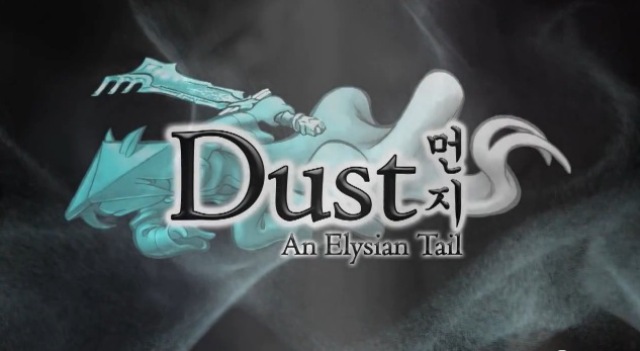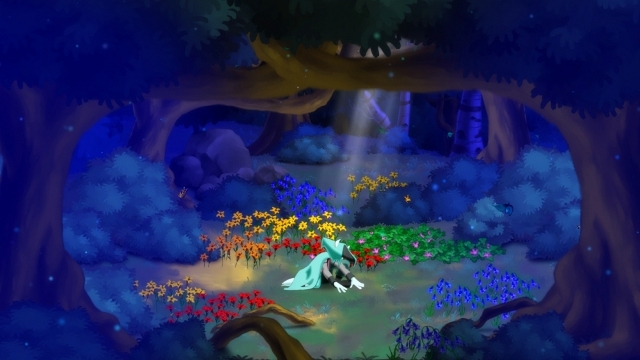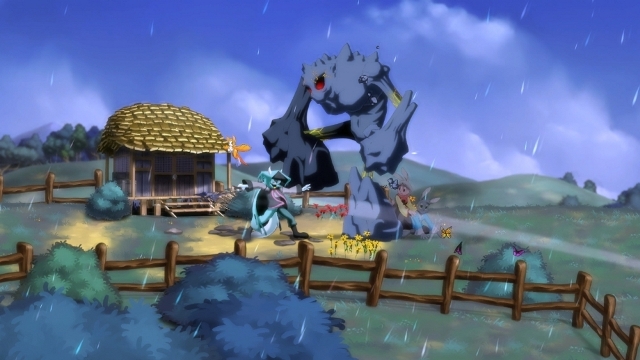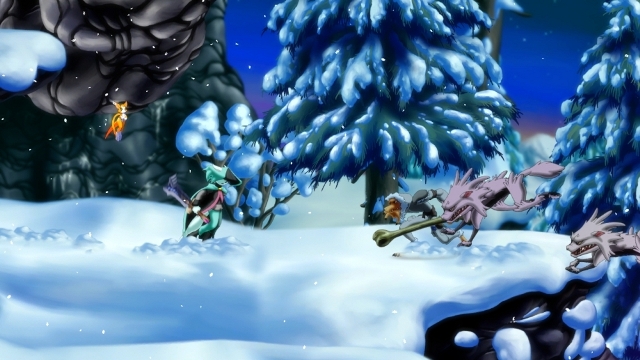Dust: An Elysian Tail review (XBLA)
Dust: An Elysian Tail was developed by Humble Hearts and published by Microsoft Studios. It was released on August 15, 2012 for 1200 MSP. A copy was provided for review purposes.
Dust: An Elysian Tail opens with a lone figure awakening in a forest with no memory of his past. The mystical, obviously powerful blade he comes into possession of assumes the dual roles of death-dealer and imparter of wisdom; its cagey words imply that it knows more about the main character and the quest he is destined to embark upon than it is willing to reveal just yet. A cutesy and somewhat annoying sidekick flies alongside, providing help and occasionally pointing out the obvious. Once the opening scene closes, players move left to right and merrily hammer away at face buttons to dispatch beasties marching towards them on a 2D plane, all of it accomplished in stunning effect thanks to gorgeous hand-drawn art. There are peaceful villages besieged by overpowering forces and inhabited by locals in need of a hero to carry out various quests, and it’s not long before the environment betrays the fact that the completionist player will be revisiting areas later on to accumulate all of the hidden goodies once more skills have been unlocked.
It all sounds fun, right? Of course it does, but it’s probably also sounding a bit familiar at this point. Here’s the good news: there is much more to Humble Hearts’ Dust: An Elysian Tail than can be summed up in a handful of broad sentences about its action-adventure game tropes. Yes, it shares much with other throwback side-scrollers, and the sole member of the game’s development studio, Dean Dodrill, is unlikely to hear any complaints about that fact. But his studio’s debut effort also establishes an excellent identity all its own. Dust is a joy to play and the star of Microsoft’s 2012 Summer of Arcade lineup. There are some issues with pacing, voice work and the framerate hiccup, but wonderfully charming artwork, a wealth of content and a combat system that just feels right will allow gamers to look past the issues and enjoy Dust for many hours.
Here’s what we liked:
Ooh, pretty – Dust looks fantastic. Its art style is simple and recalls a bygone era of animated movies, a time before Pixar came on the scene and effectively killed off this approach to animation on the big screen. Things aren’t quite that bleak for hand-drawn illustrations in gaming these days, but Humble Hearts’ work still stands out as some the most visually pleasing around. Some early sections of the game do a great job of showing off the bright and cheery parts of the world that have been left mostly unspoiled by the war plaguing the lands. Another area goes in the opposite direction and displays gloomy, dying lands inhabited by appropriately nasty baddies that benefit from the same pleasing art direction. No matter where players travel in the game they will encounter gorgeous landscapes and enemy designs that they will not soon forget.
Slash and burn – Pretty visuals are great and all, but they can only carry a game so far. Thankfully, Dust has stellar gameplay to back up its visuals. The combat system isn’t particularly complicated, but it sure is addictive. Hammering out sword combos with X and Y is fun all on its own. Throw in the abilities like streaking through the sky in a whirling mess of destruction and raining down hell by having sidekick Fidget throw deadly dust into the mix and things get really good. Racking up combos with four digits’ worth of hits is easy when these moves are combined smartly.
That’s a reference! – Dodrill was well aware that the type of gamer who would be attracted to his work appreciates a good reference to other games, and so he rode that horse hard. It’s not long into the adventure that players will hear Fidget smugly channel a certain meme-tastic merchant. Venture deeper into the game and look harder and a slew of other game and movie references will pop up, including a number of “friends” that pay homage to characters from other games. A bad reference can make audiences cringe. Thankfully, these are damn good references.
So much to do, so much to see – Dust is a long game, longer than many of today’s $60 retail releases. The main quest alone stretches into double-digit hours, and the Metroidvania elements and higher difficulty levels will have completionists coming back for much, much more. Secrets are never in short supply in this game, and nearly every NPC has misplaced some whatchamajigger or another or needs help tracking someone down. If collecting everything and aiding everyone is your thing, then you’ll want to fully explore every corner of every map.
Here’s what we didn’t like:
Little Fidgets should be seen and not heard – At this point the voice-overs versus text-only debate feels almost as old as the classic games that inspired Humble Hearts. It appeared to have been all but won, too, but Dust puts an emphatic check in the silence is golden column. The game often sounds as bad as it looks good when characters open their mouths. Fidget is perhaps the biggest offender. The little flying fuzzy blabbermouth that accompanies Dust is as easy on the ears as fingernails across a blackboard. Meanwhile, various other NPCs slip slightly out of their accents at times. On the bright side, the protagonist is one of the better-voiced characters in the game. Also appreciated is the ability to skip through dialogue by tapping A.
Mind your pace – Things sometimes proceed at a brisk clip in Dust, and the game often makes the player feel like they could endlessly fight hordes of its baddies and never grow. Unfortunately, there are other points in the adventure when things grind to a halt. Much of the story is so transparent that certain NPCs would do no more to tip players off as to where it’s going where they to face the camera and read lines of dialogue from a few hours further into the narrative, which doesn’t help the urge to escape forced dialogue and return to the fighting in a hurry all the more potent. Additionally, players are also sometimes forced to retrace their steps within areas of the game and slog through the same batches of enemies over and over again in order to break barriers that impede progress. It is possible to fast-travel around the overworld. The ability to freely do so between a few points within the same area would have been most welcome.
Yes, Dust has a few minor aggravations that are worth noting. Aside from the aforementioned occasional framerate dips, though, there isn’t a whole lot else to gripe about. A beautiful world filled with memorable enemies blissfully unaware of how much fun players are about to have unleashing Dust’s powers on them makes this an adventure worth embarking on. And although the pace sometimes breaks down, the abundance of content is still something to be appreciated in today’s world of increasingly light single-player experiences. Dodrill has flipped the Summer of Arcade, and it came up (Elysian) tails.
Score: Buy It





